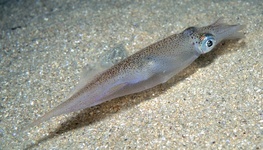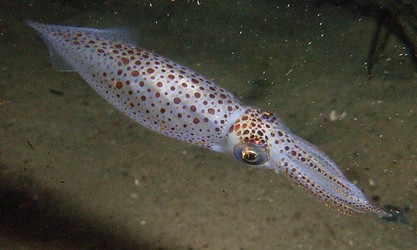Alloteuthis subulata
Michael Vecchione and Richard E. YoungCharacteristics
- Mantle
- Mantle long and narrow.
- Anterior ventral mantle margin shallowly curved.
- Tail long and pointed in adult females (length of posterior extension plus fins 66% of dorsal mantle length) and very long and spike-like in adult males (72% of dorsal mantle length).
- Fins
- Fin width index (width of both fins as a percentage of dorsal mantle length) 23% in adult females and 10% in adult males.
- Posterior borders concave and extending along tail.
- Buccal crown
- Buccal lappets without suckers.
- Arms:
- Arm length medium to short.
- Arm suckers with 6 to 10 square teeth on dista1 half, smooth on proximal half.
- Left ventral arm hectocotylyzed, with 6 to 8 pairs of normal suckers proximally, followed distally by 2 longitudinal series of fine papillae.
- Tentacles
- Tentacles short, delicate.
- Clubs small, narrow.
- Median manal suckers small.
Habitat and Biology
Usually associated with sandy and hard bottoms, occurring at depths down to 200 m. In the North Sea, males and females arrive together in inshore waters in early summer. The sole spawning season is restricted to June and July. Juveniles of 2 mm ML hatch after a few weeks; they first occur in plankton samples toward the end of July; after about 15 to 30 days they shift to the demersal life habits of the adults; by November, at an age of 3 months (size about 3 cm ML), they leave the North Sea until the following spring (size about 5 cm ML). Longevity is between 1 and 2 years. The species feeds on small and juvenile fishes.
Geographic Distribution
Eastern Atlantic: North Sea and western Baltic Sea south to the Sahara Banks, extending into the Mediterranean Sea.
Other Names for Alloteuthis subulata
- Vernacular Names: En: European common squid, Fr: Casseron commun, Sp: Calamarín picudo, Local species names: Italy: Calamaretto
Title Illustrations

| Scientific Name | Alloteuthis subulata |
|---|---|
| Location | Off Cascais, Portugal |
| Specimen Condition | Live Specimen |
| Identified By | Peter Wirtz |
| View | Dorsal-oblique |
| Copyright |
© 2007 Peter Wirtz

|
About This Page
Michael Vecchione

National Museum of Natural History, Washington, D. C. , USA
Richard E. Young

University of Hawaii, Honolulu, HI, USA
Correspondence regarding this page should be directed to Michael Vecchione at
vecchioneM@si.edu
Page copyright © 2010
 Page: Tree of Life
Alloteuthis subulata .
Authored by
Michael Vecchione and Richard E. Young.
The TEXT of this page is licensed under the
Creative Commons Attribution-NonCommercial License - Version 3.0. Note that images and other media
featured on this page are each governed by their own license, and they may or may not be available
for reuse. Click on an image or a media link to access the media data window, which provides the
relevant licensing information. For the general terms and conditions of ToL material reuse and
redistribution, please see the Tree of Life Copyright
Policies.
Page: Tree of Life
Alloteuthis subulata .
Authored by
Michael Vecchione and Richard E. Young.
The TEXT of this page is licensed under the
Creative Commons Attribution-NonCommercial License - Version 3.0. Note that images and other media
featured on this page are each governed by their own license, and they may or may not be available
for reuse. Click on an image or a media link to access the media data window, which provides the
relevant licensing information. For the general terms and conditions of ToL material reuse and
redistribution, please see the Tree of Life Copyright
Policies.
- First online 02 September 2010
- Content changed 02 September 2010
Citing this page:
Vecchione, Michael and Richard E. Young. 2010. Alloteuthis subulata . Version 02 September 2010 (under construction). http://tolweb.org/Alloteuthis_subulata/52721/2010.09.02 in The Tree of Life Web Project, http://tolweb.org/











 Go to quick links
Go to quick search
Go to navigation for this section of the ToL site
Go to detailed links for the ToL site
Go to quick links
Go to quick search
Go to navigation for this section of the ToL site
Go to detailed links for the ToL site